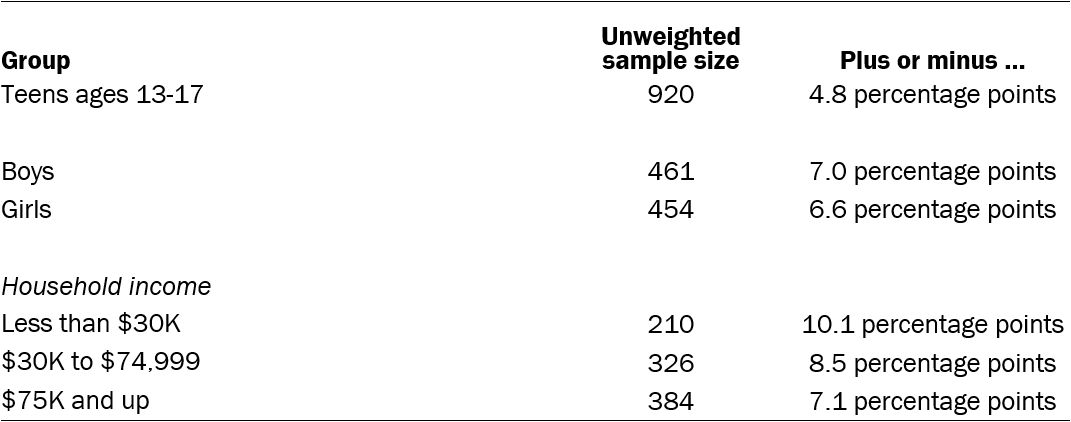Teens survey methodology
The teens survey was conducted using the NORC AmeriSpeak panel. AmeriSpeak is a nationally representative, probability-based panel of the U.S. household population. Randomly selected U.S. households are sampled with a known, nonzero probability of selection from the NORC National Frame, and then contacted by U.S. mail and telephone. A subsample of nonresponding households is selected to receive additional, in-person follow-up from field interviewers. More details about the NORC AmeriSpeak panel methodology are available here.
This particular survey featured interviews with 920 teens ages 13 to 17. Interviews were conducted online and by telephone from Sept. 17 to Nov. 25, 2018. Of the 920 teens, 389 were sampled directly from NORC’s AmeriSpeak Teen Panel. These are teens living in empaneled households who have already agreed to participate in surveys and for whom parental consent has already been obtained. The remaining 531 teens came from a sample of AmeriSpeak households known to have at least one child ages 12 to 17. In these households, sampled adults were screened to confirm that they were the parent or guardian of a teen ages 13 to 17 and were asked to solicit the participation of their teen. Interviews are conducted in both English and Spanish.
The teens survey had a survey completion rate of 55% (920 completed interviews out of 1,683 screened eligible panelists for whom parental consent was granted). After accounting for nonresponse to the panel recruitment surveys, attrition, and nonresponse to the parental screener, the weighted cumulative response rate for the teens survey is 5%.
The AmeriSpeak teen sample was weighted in a multistep process that began with the panel base sampling weights that reflect each household’s probability of selection and the fact that some households are subsampled for in-person nonresponse follow-up. These household-level weights were then further adjusted for nonresponse and unknown eligibility. These household-level weights were passed on to all eligible adults in each participating household and further adjusted to correct for within-household nonresponse, and calibrated to match the U.S. Census Bureau’s Current Population Survey (CPS) on age, sex, education, race/Hispanic ethnicity, housing tenure, telephone status and census division to create the final panel weights.
Empaneled teens already belonging to the AmeriSpeak Teen Panel received the same weight as their parent. For the 389 who completed the survey, a nonresponse ratio adjustment was performed using the teen’s age, gender, race/ethnicity, and their parents’ highest level of education.
For parents who completed the screener and consented to their child’s participation, a ratio adjustment was performed using the parents’ age, gender, race/ethnicity, and education to correct for nonresponse and non-consent. This weight was then passed on to the eligible teen. For the 531 non-empaneled teens recruited through their parents, a final ratio adjustment based on their parents’ age, gender, race/ethnicity and education was performed.
Finally, the empaneled and non-empaneled teens were combined, and the data were raked to match the 2018 CPS March supplement with respect to age, gender, race/Hispanic ethnicity, census division, parents’ highest level of education and household size.
Sampling errors and statistical-significance tests take into account the effect of weighting. The following table shows the unweighted sample sizes and the error attributable to sampling that would be expected at the 95% level of confidence for different groups in the survey:

In addition to sampling error, one should bear in mind that question wording and practical difficulties in conducting surveys can introduce error or bias into the findings of opinion polls.
Sample sizes and sampling errors for other subgroups are available upon request.
© Pew Research Center, 2019


